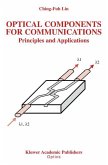There has been a revived interest in Raman amplification due to the availability of high pump powers and improvements in small core size fibers. Two general categories of Raman amplifiers exist: distributed and discrete, also known as DRAs. They improve the noise figure and reduce the nonlinear penalty of the amplifier, allowing for longer amplifiers spans, higher bit rates, closer channel spacings, and operation near the zero dispersion wavelength. DRAs are already becoming commonplace in most long-haul networks. Consequently, Raman amplifiers should see a wide range of deployment in the next few years. This edited monograph is written by leading experts in this area and is the first book entirely devoted to Raman amplification. Three sections include extensive background on Raman physics, descriptions of sub-systems and modules utilizing Raman technology, and a review of current state-of-the-art systems. Technologies presented include applications for long-haul and ultra-long-haul submarine, terrestrial, soliton, and high-speed systems. This book will be a resource for scientists and optical engineers in optoelectronics, fiber optics, telecommunication, and optical networks.
I remember vividly the ?rst time that I heard about the ?ber ampli?er. At that time, of course, it was the erbium-doped ?ber ampli?er, the predecessor of the Raman ampli?er that is the subject of this book. It was an early morning in a forgotten year in Murray Hill, New Jersey at one of our Bell Labs monthly research staff meetings. About twenty directors and executive directors of research organizations clustered around a long table in the imposing executive conference room. Arno Penzias, the vice president of research, presided at the foot of the table. Everyone who participated in those research staff meetings will long remember their culture and atmosphere. Arno would pick an arbitrary starting point somewhere around the table, and the designated person would head to the front of the table to give a short talk on "something new" in his or her research area. This ?rst speaker would invariably ?ddle helplessly with the controls embedded in the podium that controlled the viewgraph projector, but eventually we would hear machinery grinding in the back room as a large hidden mirror moved into place. We would all wait quietly, arranging and choosing our own viewgraphs from the piles that lay on the table in front of every participant.
I remember vividly the ?rst time that I heard about the ?ber ampli?er. At that time, of course, it was the erbium-doped ?ber ampli?er, the predecessor of the Raman ampli?er that is the subject of this book. It was an early morning in a forgotten year in Murray Hill, New Jersey at one of our Bell Labs monthly research staff meetings. About twenty directors and executive directors of research organizations clustered around a long table in the imposing executive conference room. Arno Penzias, the vice president of research, presided at the foot of the table. Everyone who participated in those research staff meetings will long remember their culture and atmosphere. Arno would pick an arbitrary starting point somewhere around the table, and the designated person would head to the front of the table to give a short talk on "something new" in his or her research area. This ?rst speaker would invariably ?ddle helplessly with the controls embedded in the podium that controlled the viewgraph projector, but eventually we would hear machinery grinding in the back room as a large hidden mirror moved into place. We would all wait quietly, arranging and choosing our own viewgraphs from the piles that lay on the table in front of every participant.








